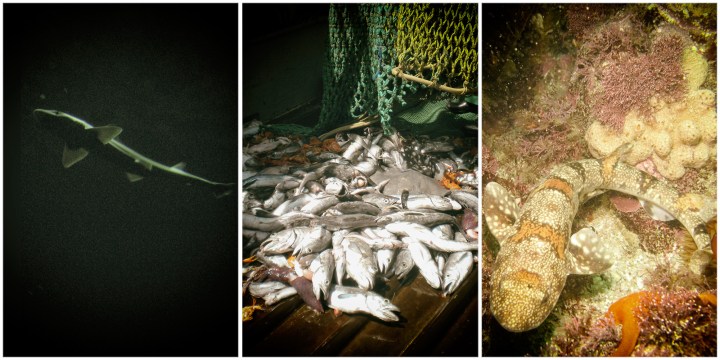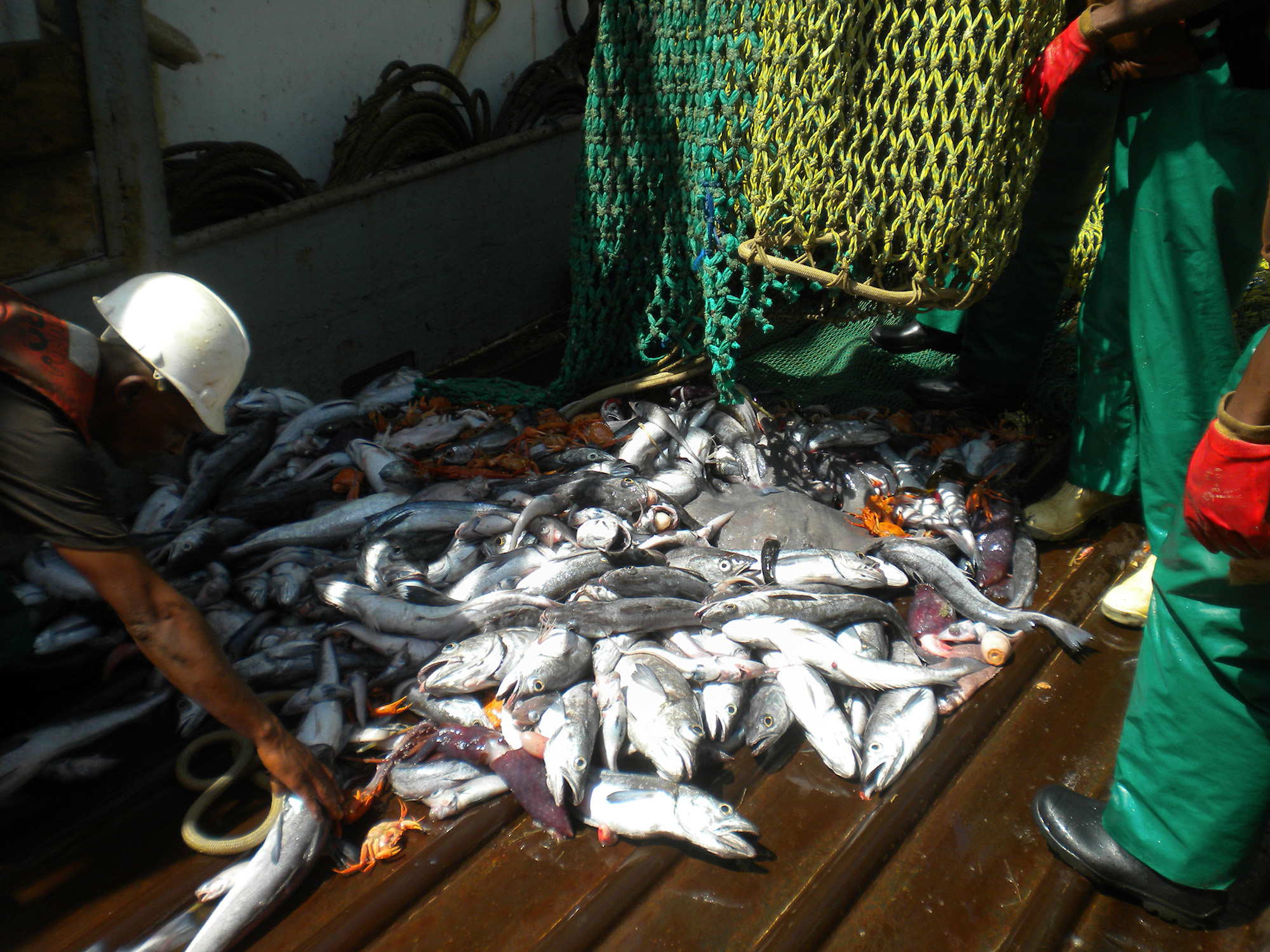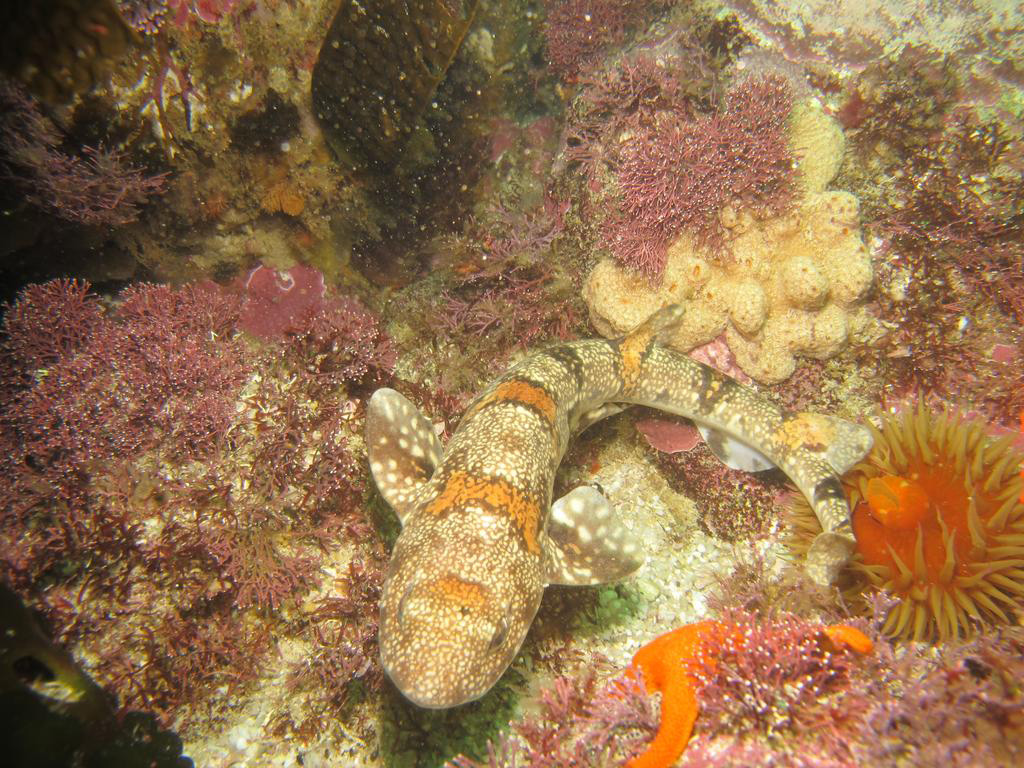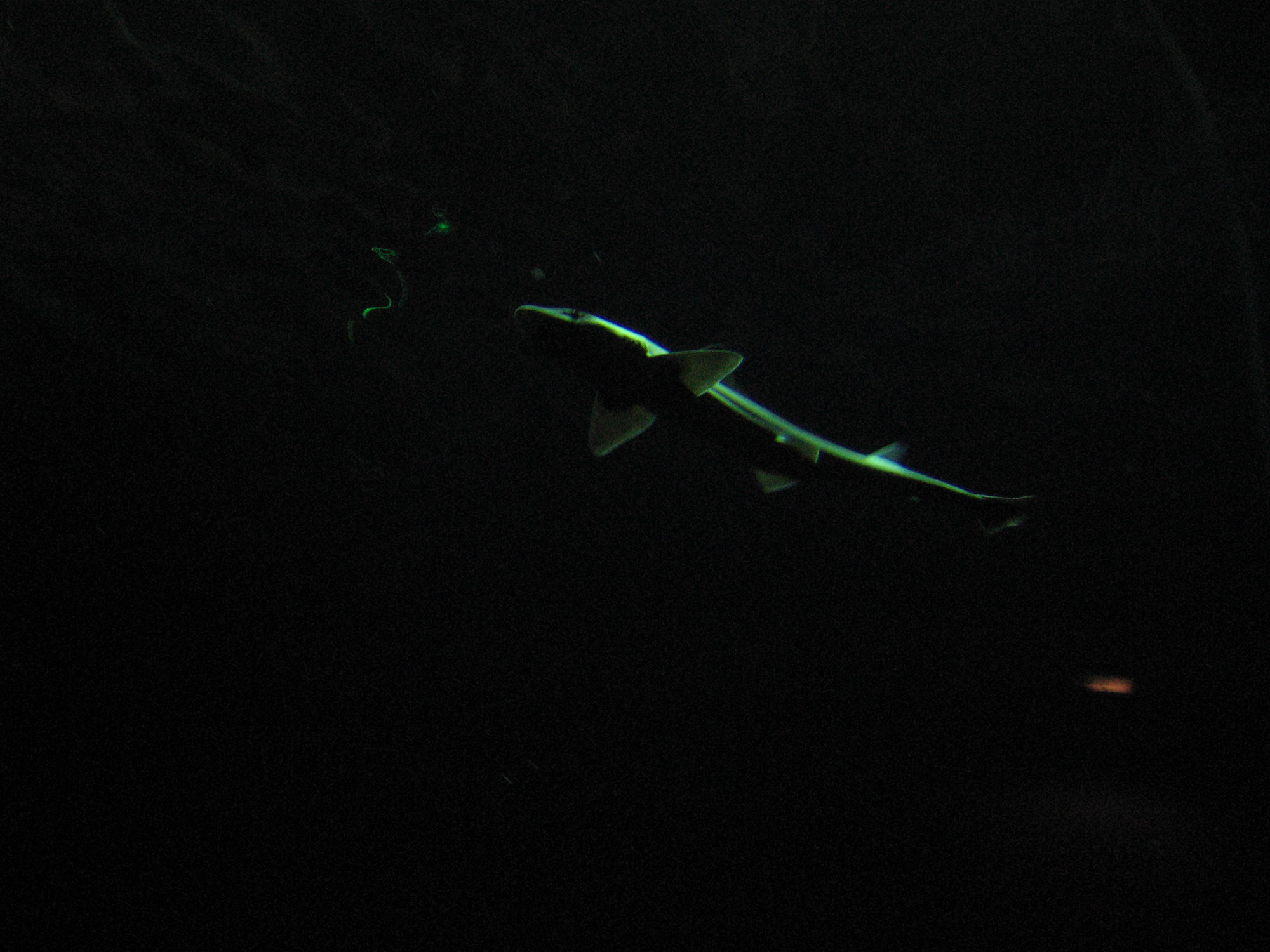OCEAN WATCH
Limited monitoring and government oversight depleting shark populations

Amid government failure to properly monitor the impact of deep-sea fisheries, numbers of rays and sharks are dwindling.
South Africans love seafood. Fish and chips, prawn curry, crab curry and pickled fish are just a few of the dishes deeply rooted in our cultures. Most of us, however, have little idea where or how these animals are caught.
And while the prices in the supermarket seem plain enough, the true ecological cost of our seafood is another matter.

A catch is sorted aboard a Cape trawler. Sharks and rays are frequently found among the bycatch during demersal trawling for hake. (Photo: CapMarine)
Although South Africa is, according to Biofin, the third most biodiverse country in the world and home to more than 200 species of sharks and rays – 34% of which are found only in our oceans – there are concerns that these creatures are increasingly under threat.
One of the ways fishermen catch our favourites, like hake and prawns, is through demersal trawling. This involves dragging a heavy, cone-shaped net along the seabed to herd and capture bottom-dwelling fish.
Sharks and rays often make up part of what is known in the industry as bycatch. These are fish and other forms of sea life caught indirectly to the target species in a fishery. If commercially viable, they are sometimes kept and processed; if not, they are discarded – typically tossed back into the ocean.
Rich pickings
Demersal hake trawling is South Africa’s most valuable fishery, according to the United Nations Food and Agriculture Organisation and others. Sales of hake alone are valued at over R4-billion annually. In total, the fishery contributes around R6.7-billion to South Africa’s economy each year, while providing over 35,000 jobs directly and indirectly.
But this method of fishing damages the seafloor and is unselective in its catch. Recent stock assessments and a study by researchers from the Department of Environment, Forestry & Fisheries and TRAFFIC, the wildlife monitoring network, found that bottom trawl hake fisheries may pose the greatest threat to the survival of some chondrichthyans – a class of sea life that includes sharks, skates, rays and chimeras.
Hake is typically caught on the continental shelf edge, from the Namibian border southwards and between Cape Agulhas and Port Elizabeth, where many of South Africa’s sharks and rays are also found.
Hake is very much the target for the demersal trawlers when they set out to sea (sometimes for up to a month), but a variety of sharks and rays are frequently caught too.
This adds to the overfishing pressures sharks and rays are already facing from other forms of fishing, including long-line fishing and the black market trade in shark fins (finning is banned in South Africa).
Chondrichthyans can live for many years and are slow-growing and late to mature. They produce relatively few offspring, making it hard for them to rebound if overfished, with many species taking decades to recover.
When it comes to demersal trawling, little is known about the survival rates of the sharks and rays that are thrown back. Sharks are often dangerous to handle and poor handling practices – sometimes unavoidable when dealing with a distressed shark – coupled with the length of time that piles of bycatch lie on deck, significantly reduces survival rates.
Limits of monitoring

The endangered Puffadder Shyshark in False Bay, Cape Town. (Photo: Flickr / Derek Keats)
The South African Deep-Sea Trawling Industry Association (SADSTIA) funds an in-house scientific observer programme, with monitors aboard trawlers. The programme is among a number of sustainability measures the association advocates, but it has its limits.
It’s hard, for example, for monitors to confirm if sharks and rays are still alive when returned to the sea – something researchers have flagged as a serious concern, requiring attention.
About 70 species of chondrichthyans, including dogfish, catshark and skate species, are among the demersal hake fishery bycatch.
Dr Charlene da Silva, a researcher with the Department of Environment, Forestry and Fisheries, confirmed that some of the country’s endemic catsharks – including the puffadder shyshark and tiger catshark – are classified as endangered. Species caught by fisheries such as the yellow-spotted skate and twineye skate are listed as vulnerable and endangered, respectively. None of these is a fisheries target species.
Da Silva said soupfin shark stocks were a particular worry and catches needed to be reduced across all commercial fishing industries. Soupfin sharks were recently listed as critically endangered by the International Union for Conservation of Nature. These are often targeted by commercial line fishers and are part of the bycatch in demersal longline and inshore demersal trawl fisheries.
Although bycatch is unavoidable in trawling, poor identification and record-keeping make it hard to quantify how many chondrichthyans are caught.
According to the Status of the South African Marine Fishery Resources (2016), stock assessments of sharks have in the past been hindered by a lack of independent fisheries data, poor data quality and few studies on the life history of sharks.
Bycatches of sharks and rays – when recorded at all – are often lumped together at a genus or even family level. Species are sometimes misidentified, and a dearth of species-specific bycatch data frustrates efforts to accurately predict population dynamics, essential for effective conservation, according to the World Wide Fund for Nature (WWF).
All at sea
Placing more and better-resourced observers aboard more trawlers to monitor bycatch would help, but it’s said to be expensive (Roving Reporters could not obtain exact figures) for the fisheries companies that fund it. It also deprives trawlers of bunk space needed for crew and – more recently – runs into Covid-19 social distancing difficulties.
Compounding the problem is an apparent lack of government oversight.
In 2011 the Department of Agriculture, Forestry and Fisheries halted its own offshore resource observer programme.
The programme included all the hake fisheries as well as inshore and midwater fisheries, longlining and prawn fishery and its closure continues to draw sharp criticism from observers and industry figures.
These critics have questioned what becomes of the levies (about R46.7-million in the 2019/20 financial year) paid to the department, as the industry sees it, partly to fund a now-defunct programme.
The Department of Agriculture, Forestry and Fisheries, and the Department of Environmental Affairs were merged into the current Department of Environment, Forestry and Fisheries in 2019.
In the past, concerns were raised about the governance of the former Department of Agriculture Forestry and Fisheries.
Corruption claims
Johann Augustyn, secretary of the South African Deep-Sea Trawling Industry Association, puts the blame squarely at the door of the former Department of Agriculture, Forestry and Fisheries.
“The observer programme (a responsibility of the government) was halted because the efforts to issue the contract again by the Fisheries Research and Development Chief Directorate were continually frustrated by corrupt officials in the department,” he said in an email to Roving Reporters.
Pleas of poverty from the department and its successors cut little ice with Augustyn, who was formerly its chief director: marine resource management as well as fisheries research and development.
He noted that sometime after the department halted the programme the then deputy director-general responsible for it “simply said it should be paid for by industry (which was already the case, but we wanted the department to meet its own responsibilities). Now they are saying that they simply do not have the budget for it.”
Augustyn said the levies money was insufficient to cover everything the department used it for – including purposes unrelated to the sector.
Industry watchers have also questioned the management of the Marine Living Resources Fund and noted that levies had not been adjusted for more than 10 years.
Fund foibles

The Soupfin Shark (Galeorhinus galeus). (Photo: Flickr / Oregon Coast Aquarium)
The fund finances the department’s fisheries branch, which is responsible for managing and monitoring the sustainable uses of marine living resources and protecting the marine ecosystem.
In recent years the fund, which relies heavily on government grants and subsidies in addition to levies on fish landed and fish products, has received disclaimed and qualified audit reports with findings.
Several senior department officials have in past years been placed on precautionary suspension, and a number of senior department posts remain vacant.
Investigations are continuing into various allegations of fraud, corruption, money laundering, contraventions of the Public Finance Management Act and Treasury regulations.
Officials have told Parliament of “leadership challenges” and the Auditor-General, in its most recent report on the fund, flagged a host of concerns including over risk management, irregular, fruitless and wasteful expenditure and non-compliance with laws and regulations.
Moving in the right direction
In reply to questions from Roving Reporters, the department said it was untrue that corrupt officials had stymied its observer programme. No staff were currently on suspension, it said, but conceded there were a number of critical vacancies in the fisheries branch – which it was in the process of filling.
Department spokesman Zolile Nqayi insisted “budgetary constraints” were to blame for the closure of its observer programme, but said: “It should be noted that in many countries, the costs of a scientific observer programme are borne by industry and/or right holders and not by the state.”
Nqayi pointed out that South African long-line tuna fisheries in the Indian and Atlantic oceans were required by regional and international conventions to have 10% and 20% observer coverage respectively. A figure of 100% applied to foreign vessels.
The cost of all of this was met by the long-line tuna fisheries – which achieved far higher observer coverage figures than the local hake industry, he said.
But Augustyn counters that in some countries where levies are raised on industry, these are managed by fisheries authorities as part of government scientific programmes. Levies are also linked directly to rights owned by industry – “but this is not the case in South Africa”.
Nqayi said levies were used to achieve the broader objectives of the Marine Living Resources Act and to cover fisheries’ branch operational costs. “The levies are therefore used to ensure that the country’s marine resources are sustainably harvested to ensure future generations can continue to harvest our marine resources.”
The department was striving to improve governance and administration of the Marine Living Resources Fund, as shown by the improved audit outcome it had received, he said.
Nqayi was referring to the qualified opinion the Auditor-General gave the fund in 2019/2020 compared with the previous period when it received a more serious, disclaimer opinion.
On criticism that levies had not been increased for more than 10 years, Nqayi turned the tables. “Industry did not agree with the cost recovery model that was proposed. Industry was of the view that the current levies are not affordable and certain sectors are continuously seeking relief from paying levies,” he said, but added that the department intended to raise levies this year, following public consultations.
Valuable information
Leaving aside the debate on who should pay for it, the South African Deep-Sea Trawling Industry Association’s own observer programme continues to provide valuable information needed to maintain its certification with the Marine Stewardship Council.
MSC certification attests to a fishery meeting international standards for sustainable fishing. It’s about ensuring the long-term health of fish stocks.
Seafood from MSC-certified fisheries bears the blue MSC mark on its packaging, assuring consumers they are buying from a sustainable fishery. The South African hake trawl fishery has recently achieved its fourth MSC certification.
Every year the industry association’s programme covers about 40% of its members’ trawl footprint. This translates to about 6% coverage of the actual trawling effort – the percentage of trawl nets pulled up and observed. The association is aiming for 10% trawling effort coverage.
The industry association works with CapMarine, which provides trained observers and consults to maritime industries.
‘Raising the bar’
Stewart Norman, observer programme co-manager and director of CapMarine, said the MSC certification “continued to raise the bar” for the industry when it came to providing evidence on bycatch.
“Substantial comparative work… between observers, between vessels, between sub-fleets and between observer data and research data has shown the observer data to be of good quality with respect to catch composition,” Norman told Roving Reporters.
Bunk space on trawlers hampered efforts to put more observers on board, but “these limitations are being resolved in part by the advent of electronic monitoring in the fishery”.
He felt there was room for improvement in the identification of infrequently encountered skates and rays, but this was “more of an issue at landing monitoring and commercial catch statistics reporting than it is for the observer programme”.
CapMarine regularly reviewed its monitoring, he said, and made it a priority to monitor vessels that might have been missed in previous years. “More often than not” observers were meeting their targets.
“A stratified placement approach is being investigated whereby each right holder/fishing company would carry observers proportionate to the volume of total allowable catch allocated to it and the number of active vessels and sea-days allocated (total allowable effort),” he said.
Norman said the South African Deep-Sea Trawling Industry Association implemented a “trawl ring-fence” area in 2006 to prevent trawling in natural hake refuges. No further trawling was allowed in these areas unless an environmental impact assessment process was completed. The areas represent about 4.4% of South Africa’s territorial waters.
Wider responsibility

The endangered Tiger catshark. (Photo: Flickr / Enoshima Aquarium)
No monitoring process is ever perfect, and the department’s role remains a concern, but consumers need to do their bit too.
Times have changed. Few of us now go out to hunt or fish for our food, but we ought to hold ourselves more accountable for what we eat by making informed decisions. The cost to our environment of destructive fishing practices will only grow with the increasing loss of sharks and rays.
One of the ways consumers can help ray and shark conservation is by getting the Southern African Sustainable Seafood Initiative’s list, pocket guide or smartphone app. These tools let you quickly check whether a particular fish for sale in a shop or restaurant can be eaten without harm to the environment.
According to the WWF’s sustainable seafood initiative, more effort and research is needed to improve at-sea scientific observations of fishing. This would help us to better understand its impact on ecosystems. Observers with a specific focus on sharks and rays would enhance the quality of data gathered immensely.
Sustainable use
The Marine Living Resources Act recognises the need to use South Africa’s resources sustainably and suggests a broader, ecosystem approach to management.
The government must reinstate an official observer programme and guides to aid in accurate identification of chondrichthyan species should be made available on all trawlers.
The closure of fishing areas in certain seasons and the proclamation of more marine protected areas would also help to give shark and ray stocks more opportunity to recover.
Think shark
Sharks are apex predators and control the population dynamics of many species. They are critically important for the health of our seas. At the same time, shark tourism has considerable potential in South Africa. Removing sharks from our ecosystem is bad for the ocean and bad for us.
We need to start thinking harder about how and what we are catching or what’s on our plate: food for thought the next time you tuck into your favourite plate of fish and chips, prawn curry, or that Easter pickled fish. DM
This story arises from an Ocean Watch writing project supported by the Earth Journalism Network (EJN), and Youth 4MPAS. The project enables conservation-minded youth to share their passion and develop writing skills with mentorship from Roving Reporters. Story pitches can be emailed to [email protected]. The opinions and views expressed in this article are not necessarily those of the EJN or Youth4MPAs.
Katie Biggar is a marine biologist (BSc Honours – Marine Biology, from UKZN) and a freelance writer. She is passionate about environmental and ocean education. She recently won the NEW Pitch Stories of Hope competition, a filmmaking initiative that empowers youth from across Africa to make conservation-themed films. She is now working on a short documentary about her hometown and the next bird facing extinction in South Africa — the Montane blue swallow. Biggar has also been working on several poetry, fiction and nonfiction writing projects.



















 Become an Insider
Become an Insider
Symptomatic of a failed state, the department measures its effectiveness and success from the bottom, meaning total failure is their default position and anything above that is viewed positively. Public sector wages are above private sector wages in SA so the failing state pays a lot for a little.